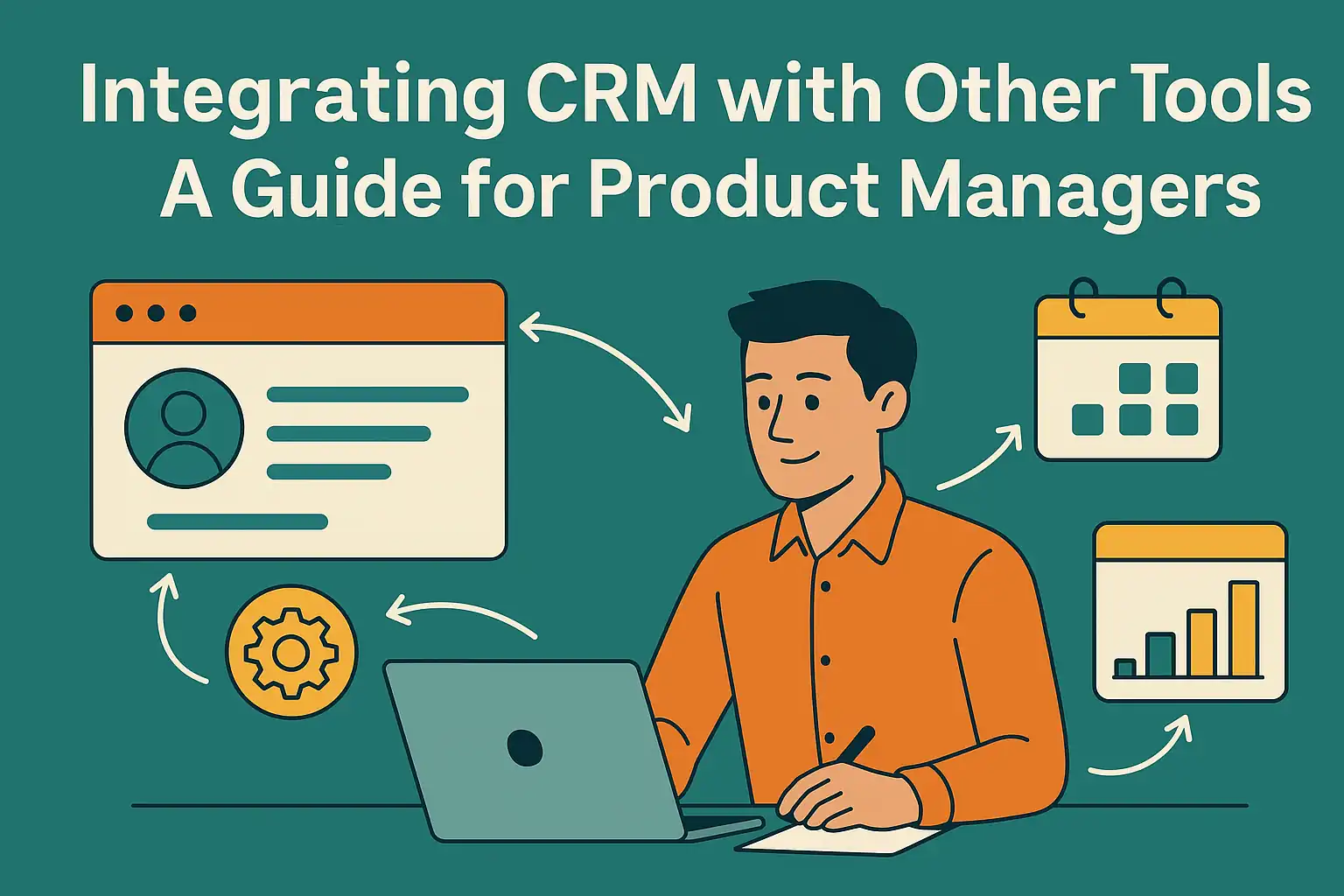Introduction
Effective management of customer relationships is crucial for success. This is where Customer Relationship Management (CRM) systems come into play. A CRM is a technology that helps organizations manage interactions with current and potential customers, streamlining processes, and improving profitability. CRMs serve as a vital tool that not only enhances communication and collaboration among teams but also provides valuable insights into customer behavior and preferences. By leveraging CRM systems, product managers can ensure that their projects align with customer needs, ultimately driving better outcomes.
Integrating CRM with other tools within the tech ecosystem is essential for maximizing its potential. When a CRM is connected with various applications—such as project management software, email marketing platforms, and analytics tools—it creates a seamless flow of information. This integration allows for real-time data sharing, reduces the risk of errors, and enhances overall productivity. For product managers, this means having a comprehensive view of customer interactions and project progress, enabling them to make informed decisions and adapt strategies as needed.
The target audience for this guide includes tech-savvy product managers and IT leaders who are looking to optimize their CRM systems and create a cohesive tech ecosystem. These professionals understand the importance of integrating various tools to enhance operational efficiency and improve customer engagement. By exploring effective strategies for CRM integration, product managers can foster a more collaborative environment, streamline workflows, and ultimately drive business growth.
Understanding the Tech Ecosystem
A tech ecosystem refers to the interconnected network of software applications, tools, and platforms that work together to enhance business operations and drive efficiency. This ecosystem is composed of various components, including:
- Core Software Applications: These are the primary tools that organizations rely on, such as Customer Relationship Management (CRM) systems, project management software, and enterprise resource planning (ERP) systems.
- Integration Platforms: Middleware and integration platforms facilitate communication between disparate systems, allowing for seamless data flow and functionality across applications.
- APIs and Connectors: Application Programming Interfaces (APIs) enable different software applications to interact with each other, while connectors serve as bridges that link various tools within the ecosystem.
- Data Sources: These include databases and third-party applications that provide essential data for analysis and decision-making.
The Role of CRM within the Ecosystem
Customer Relationship Management (CRM) systems play a pivotal role in the tech ecosystem by centralizing customer data and interactions. They serve as the backbone for managing customer relationships and are integral to various business functions, including sales, marketing, and customer service. The CRM system not only stores vital customer information but also provides insights that help product managers and IT leaders make informed decisions.
- Centralized Data Hub: A CRM acts as a centralized repository for customer information, enabling teams to access and share data easily.
- Enhanced Collaboration: By integrating with other tools, CRMs foster collaboration among different departments, ensuring that everyone has access to the same information and can work towards common goals.
Interconnectivity of CRM with Other Tools
The interconnectivity of CRM systems with other tools is essential for creating a seamless tech ecosystem. Here are some key integrations that product managers should consider:
- Project Management Tools: Integrating CRM with project management software allows teams to align customer feedback and project timelines, ensuring that product development is responsive to customer needs. This integration helps in tracking project progress and managing resources effectively.
- Marketing Automation: By connecting CRM with marketing automation platforms, businesses can streamline their marketing efforts. This integration enables personalized marketing campaigns based on customer data, improving engagement and conversion rates.
- Analytics Tools: Integrating CRM with analytics tools provides deeper insights into customer behavior and preferences. This data can inform product development and marketing strategies, allowing product managers to make data-driven decisions.
- Communication Platforms: Linking CRM systems with communication tools enhances customer interactions by ensuring that all team members have access to the latest customer information, facilitating timely and informed responses.
Key Benefits of CRM Integration
Integrating Customer Relationship Management (CRM) systems with other tools is essential for product managers aiming to create a seamless tech ecosystem. This integration not only enhances operational efficiency but also significantly improves the overall customer experience. Here are the key benefits of CRM integration that product managers should consider:
- Improved Data Accuracy and Consistency Across Platforms: By integrating CRM with other business tools, organizations can ensure that customer data is synchronized and up-to-date across all platforms. This eliminates discrepancies and reduces the risk of errors that can arise from manual data entry, leading to a more reliable data foundation for decision-making [2][15].
- Enhanced Customer Insights and Analytics: Integration allows for a comprehensive view of customer interactions and behaviors. By connecting CRM with analytics tools, product managers can gain deeper insights into customer preferences and trends. This data can be leveraged to tailor marketing strategies and improve customer engagement, ultimately driving better business outcomes [4][10].
- Streamlined Processes Leading to Increased Efficiency: Integrating CRM with other systems automates workflows, such as data syncing and follow-up communications. This automation saves time and reduces the likelihood of human error, allowing teams to focus on more strategic tasks. As a result, businesses can operate more efficiently and respond to customer needs more promptly [12][15].
- Better Collaboration Between Teams (Sales, Marketing, Support): A well-integrated CRM system fosters collaboration among different departments by providing a centralized platform for accessing customer information. Sales, marketing, and support teams can work together more effectively, sharing insights and strategies that enhance the customer journey. This collaborative approach not only improves internal communication but also leads to a more cohesive customer experience [10][14].
Strategies for Successful Integration
Integrating a Customer Relationship Management (CRM) system with other tools is essential for creating a seamless tech ecosystem that enhances productivity and customer engagement. Here are actionable strategies for product managers to ensure successful integration:
- Identify Key Tools for Integration: Begin by assessing the tools that are critical to your business operations. This may include email marketing platforms, social media accounts, analytics software, and survey tools. Understanding which systems will benefit from integration with your CRM is crucial for maximizing functionality and improving workflows. For instance, integrating survey tools can provide valuable customer insights directly to client-facing employees, enhancing service delivery and customer satisfaction [2][3].
- Utilize APIs and Middleware Solutions: To facilitate seamless data flow between your CRM and other applications, leverage Application Programming Interfaces (APIs) and middleware solutions. These technologies allow for automatic data synchronization, reducing manual entry and the potential for errors. By implementing these solutions, you can ensure that data is consistently updated across all platforms, which is vital for maintaining accurate customer records and improving decision-making processes [4][9].
- Establish Clear Objectives and KPIs: Before embarking on the integration process, it is essential to define clear objectives and Key Performance Indicators (KPIs). This will help measure the success of the integration efforts and ensure that they align with overall business goals. For example, you might set KPIs related to improved customer engagement, increased sales, or enhanced reporting capabilities. By having measurable goals, you can track progress and make necessary adjustments throughout the integration process [10][14].
- Involve Stakeholders Early in the Process: Successful integration requires collaboration across various departments. Involve stakeholders from sales, marketing, customer service, and IT early in the integration planning phase. Their insights and feedback can help identify potential challenges and ensure that the integrated systems meet the needs of all users. Additionally, fostering a culture of collaboration can enhance buy-in and facilitate smoother adoption of the new integrated systems [15].
By implementing these strategies, product managers can create a robust tech ecosystem that not only enhances the functionality of their CRM but also drives overall business success.
Common Challenges in CRM Integration
Integrating Customer Relationship Management (CRM) systems with other tools is a critical task for product managers, especially in creating a seamless tech ecosystem. However, this process is often fraught with challenges that can hinder successful implementation. Here are some of the most common hurdles product managers may encounter during CRM integration:
- Data Silos and Inconsistency Issues: One of the primary challenges in CRM integration is ensuring data quality and consistency across multiple systems. Data silos can lead to conflicting information between the CRM and other business applications, making it difficult to maintain a unified view of customer interactions and insights. This inconsistency can result in poor decision-making and a lack of trust in the data being used across the organization [3][4].
- Resistance to Change from Teams and Users: Implementing a new CRM system often meets with resistance from employees who may be apprehensive about changing their established workflows. Concerns about how the new system will affect their daily tasks, fears of losing control over data, and distrust in new methods can create significant barriers to adoption. Overcoming this resistance requires effective change management strategies and clear communication about the benefits of the new system [15][10].
- Technical Difficulties with Integration Tools: The technical aspects of integrating CRM systems with other tools can be complex. Issues such as data compatibility, the need for custom coding, and the lack of expertise in using integration tools can pose significant challenges. These technical difficulties can lead to delays in implementation and increased frustration among teams [6][11].
- Budget Constraints and Resource Allocation: Budget limitations can significantly impact the scope and success of CRM integration projects. Product managers must navigate the financial constraints while ensuring that adequate resources are allocated for training, support, and ongoing maintenance. This balancing act is crucial to avoid budget overruns and ensure that the integration meets the organization’s needs without compromising quality [4][10].
By understanding these common challenges, product managers can better prepare for the complexities of CRM integration and develop strategies to mitigate these issues, ultimately leading to a more cohesive and efficient tech ecosystem.
Best Practices for Maintaining Integration
Integrating Customer Relationship Management (CRM) systems with other tools is essential for creating a seamless tech ecosystem that enhances productivity and data flow. For product managers, ensuring the ongoing success of these integrations requires a strategic approach. Here are some best practices to consider:
- Regularly Update and Maintain Integrated Systems: It is crucial to keep all integrated systems up to date. This includes applying software updates, patches, and security enhancements to ensure compatibility and performance. Regular maintenance helps prevent issues that could disrupt data synchronization and user experience. Establishing a routine for system checks can help identify potential problems before they escalate [5][10].
- Train Teams on Using Integrated Tools Effectively: Training is vital for maximizing the benefits of CRM integration. Product managers should develop customized training programs tailored to different user groups within the organization. This ensures that all team members understand how to leverage the integrated tools effectively, which can lead to improved adoption rates and better utilization of the CRM system [3][12].
- Monitor Performance and Gather Feedback for Continuous Improvement: Implementing a system for monitoring the performance of integrated tools is essential. Regularly reviewing key performance indicators (KPIs) and gathering user feedback can provide insights into how well the integration is functioning. This information can guide necessary adjustments and enhancements, ensuring that the tools continue to meet the evolving needs of the organization [8][10].
- Adapt to New Technologies and Trends in the CRM Landscape: The technology landscape is constantly evolving, and product managers must stay informed about new trends and innovations in CRM systems. This includes exploring new integration methods, such as API-based solutions or middleware, which can offer greater flexibility and scalability. Being proactive in adapting to these changes can help maintain a competitive edge and ensure that the integrated systems remain effective and relevant [2][6][15].
By following these best practices, product managers can foster a robust and efficient tech ecosystem that supports their organization’s goals and enhances overall performance.
Future Trends in CRM Integration
As the landscape of customer relationship management (CRM) continues to evolve, product managers must stay ahead of emerging trends that can significantly impact their integration strategies. Here are some key trends to watch:
- The Rise of AI and Machine Learning: Artificial intelligence (AI) and machine learning are becoming integral to CRM systems, enabling smarter data processing and personalized customer interactions. These technologies allow for predictive analytics, which can enhance customer engagement by anticipating needs and preferences. Product managers should consider how to leverage AI capabilities to improve user experiences and streamline operations within their tech ecosystem [9].
- Increasing Importance of Data Privacy and Security: With the growing concerns around data breaches and privacy regulations, ensuring robust security measures in CRM integrations is paramount. Product managers must prioritize data protection strategies that comply with regulations such as GDPR and CCPA. This includes implementing secure data transactions, especially when integrating with third-party tools, to maintain customer trust and safeguard sensitive information [9].
- Shift Towards Cloud-Based Solutions and Remote Access: The trend towards cloud-based CRM solutions is accelerating, driven by the need for flexibility and remote access. This shift allows teams to collaborate seamlessly from different locations and devices. Product managers should focus on creating integrations that support cloud functionalities, ensuring that all tools within the tech ecosystem can communicate effectively and provide real-time data access [3][4].
- Future-Proofing Integration Strategies for Scalability: As businesses grow, their CRM needs will evolve. Product managers should develop integration strategies that are scalable and adaptable to future changes. This involves selecting tools that can easily integrate with new technologies and platforms, ensuring that the CRM system can expand alongside the business. Emphasizing modularity in integrations will allow for easier updates and the addition of new features as they become available [2][4].
Conclusion
In today’s fast-paced business environment, the integration of Customer Relationship Management (CRM) systems with other tools is not just beneficial; it is essential for creating a seamless tech ecosystem. As product managers, understanding the significance of this integration can lead to enhanced operational efficiency, improved customer interactions, and a more holistic view of customer data.
Key takeaways from our discussion include:
- Importance of Seamless Integration: Integrating CRM with various tools allows for centralized data access, fostering better teamwork across departments such as marketing, sales, and customer service. This interconnectedness enhances collaboration and streamlines operations, ultimately leading to improved customer satisfaction and increased revenue [2][7][10].
- Adopting Effective Strategies: Product managers are encouraged to implement the strategies outlined in this guide. By assessing integration needs, defining clear goals, and leveraging APIs for real-time data updates, you can ensure that your CRM system aligns with your organization’s overall business objectives. This strategic planning is crucial for optimizing customer relationship strategies and achieving key business priorities [5][8][9].
By embracing these strategies and fostering an environment of shared knowledge, product managers can significantly enhance their CRM systems’ effectiveness, driving both customer satisfaction and business success.
Find out more about Shaun Stoltz https://www.shaunstoltz.com/about/.
This post was written by an AI and reviewed/edited by a human.



